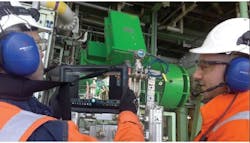Supporting offshore operations requires more than engineering and technical expertise; first and foremost, it is a logistical challenge. Surveyors, in-house technical support, and third-party contractors all need access to assets that often take days to reach. In the end, the amount of time it takes to travel to and from an offshore site can be orders of magnitude longer than the time it takes to complete the task which required the trip in the first place.
Gabriel de Moraes, Technical and Maintenance Coordinator for BW Offshore, has seen this first-hand. As an example, he cited occasions where class surveyors are needed onboard one of BW Offshore’s FPSO vessels to witness a compliance activity, e.g. a pressure tests on a boiler. “We have surveyors in Oslo that sometimes have to travel almost two days to reach a vessel in West Africa,” he said. “Quite often, the surveyor is onboard for few days depending on flight schedules, even though their activity may take just few hours.”
It should come as no surprise that a surveyor, representing DNV GL, suggested BW Offshore investigate using an augmented reality (AR) platform for remote collaboration. As it happens, Moraes had been pondering the same idea.
Remote inspection
DNV GL uses Librestream Technologies’ Onsight AR remote expert platform and Dario Buccellato, Regional Manager for Europe, America and Africa – Oil & Gas Inspection, explained DNV GL’s decision to adopt AR. “Any time there’s an innovation in the oil and gas industry, there’s a lot of debate,” he said. “Is it worth using? What’s the application?”
“Personally, I think we’re in the middle of a new revolution, where there are technologies that have all this potential, but not everyone has recognized it yet,” he added. “Remote inspection technology is definitely on that list—the technology’s ready and, as some of our customers have already recognized, we need to start using it now.”
BW Offshore is also deploying the Onsight Connect AR platform in a pilot program aboard the FPSO BW CATCHER, which operates in the North Sea for Premier Oil.
According to Librestream, the Onsight Connect AR platform is designed to create a fully collaborative environment to give teams access to augmented content for troubleshooting, assessment, and rapid resolution of issues in the field. Connect runs on smartphones, tablets, computers and smart glasses—DNV GL uses Onsight on smartphones, tablets and Windows-based computers. BW Offshore will initially be using Onsight on Windows-based tablets and a RealWear headset.
Moraes has been tasked with managing the AR project and coordinating the scope of this aspect of BW Offshore’s move toward digitalization. That includes exploring how to integrate this and similar projects in the long run. “At this stage we’re using stand-alone technologies like this in pilots, but obviously you get the maximum benefit when they’re all integrated together,” Moraes said.
Buccellato agreed. “The whole value chain of oil and gas is asking for this,” he said. “The market is driving the change, and the ones who want to perform will have no issues implementing these new technologies, because they can already see the benefits.”
Connectivity and security
As is often the case with digitalization, the first hurdle to clear is related to connectivity. During implementation of BW Offshore’s pilot program ‘ROSS’ (Remote Offshore Support and Survey), Moraes and his team have extended BW CATCHER’s existing Internet coverage to reach process modules where remote support is deemed to be most likely needed on the FPSO. Onsight’s ability to run on low bandwidth (<100kbps) weighed heavily in favor of Moraes’ decision to deploy it and having just finalized the connectivity challenges, Moraes has stated that the ‘ROSS’ pilot using Onsight AR officially began on Nov. 1, 2019.
“We’ve seen good response from customers and partners in making the upgrades necessary to do remote inspections,” Buccellato said. “There’s still work to be done in some areas, but the benefits far outweigh the costs.”
Another potential issue with augmented reality, which Buccellato pointed out, concerns security. “Data security and privacy is a big topic in the market,” he said. “Everyone wants to know if they’re going to be streaming information or recording images or videos: How is that data going to be protected?” Many companies are still hesitant to store sensitive or proprietary information in the cloud, so some hesitancy around a technology as novel as AR is understandable. Finding an AR platform supplier that is ISO-270001 certified may help alleviate that worry.
The goal—as always—is to improve asset uptime, in this case via advanced maintenance support. Rather than having to wait days to bring specialists onboard, BW CATCHER will be able to use Onsight’s remote expertise to give its offshore crew, an immediate technical support. Naturally, the pilot will run alongside traditional operations. The side-by-side comparison should provide a clear indication of the potential time and cost savings AR can bring to the oil and gas sector.
Beyond inspection
Although the pilot will initially be confined to BW CATCHER’s maintenance crew, Moraes expects to find plenty of other applications. The potential to reduce the vessel’s total number of exposure hours by cutting down on the number of necessary onsite visits is obviously appealing. “We also have a team of dedicated engineers supporting the vessel who often need to go offshore,” he said, “and I think we could save a lot of trips there as well.”
Buccellato confirmed that DNV GL has been using remote inspection in other applications as well. “We’re using it for verifications,” he said. “It’s a similar application, but there are some differences from an engineering point of view. We’re also looking into using it for various maritime applications, and for audits. The key advantage is the remote connectivity: the ability to be connected to a site, rather than having to take a plane to another country, where you spend a few days for a few hours’ activity.”



